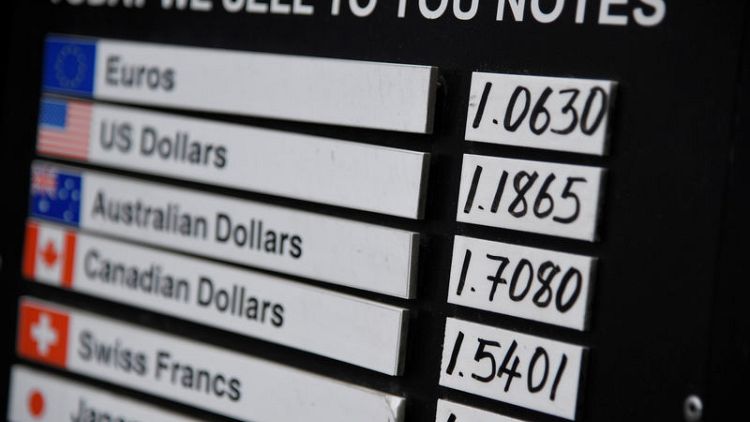By Sujata Rao and Olga Cotaga
LONDON (Reuters) - Sterling steadied on Wednesday after four days of losses, rising 0.2% against the dollar, but it was on track for its biggest monthly decline since November 2016 after investors scrambled to price in growing no-deal Brexit risks.
Trading volumes have shrunk and volatility eased after sterling's massive plunge at the beginning of this week.
Month-end sterling demand helped to stabilise the currency, said Neil Jones, head of European hedge fund sales at Mizuho. The likelihood of crashing out of the European Union without an agreements had risen, he added, but was by no means certain.
Sterling had reacted to probabilities of a hard Brexit suddenly rising to 35% to 40%, but the risk is 50% or more, he said, adding: "I expect pound volatility on the downside."
The pound's respite may not last long. Britain's new prime minister, Boris Johnson, reiterated his commitment to take Britain out of the EU by the Oct. 31 deadline regardless of whether transition agreements were in place.
The derivatives market showed sterling hedging costs remained elevated and that investors were positioned for further weakness in the British currency.
The cost of three-month implied volatility, a contract expiring around Oct. 31, increased in July to the highest since before the original deadline of March 29.
And three-month risks reversals -- a gauge of investor expectations for a currency’s direction -- pointed to a greater bias towards sterling puts versus calls, implying more depreciation. Puts allow the holder to sell the asset at a pre-agreed price; calls confer the right to buy.
However, risk reversals and implied volatility both steadied with levels far from this year's extremes.
Still, the pound has fallen more than 4% this month to the dollar and is down 8% since early May.
By 1145 GMT, it was trading at $1.2174, having touched 28-month troughs this week at $1.2120. Versus the euro, it inched 0.3% higher to 91.59 pence, off the 22-month low of 91.88 pence hit on Tuesday .
The pound is set for a third straight loss-making month versus the single currency.
Sterling may get support in coming days from asset managers looking to snap up undervalued assets.
Justin Onuekwusi, a fund manager at Legal & General Investment Management, is looking to "nudge up" sterling exposure in portfolios even though he reckons the pound will be in thrall to Johnson until parliament reconvenes in September.
"Johnson has to talk tough, especially as he has a Brexiteer cabinet. Plus parliament is on recess so there's no one to rebuff (pro-Brexit politicians). The 'Remainers' have gone quiet as they are on holiday."
NORTHERN IRELAND
The pound may move later in the day. Johnson is visiting the province of Northern Ireland, whose border with EU member Republic of Ireland has been the main sticking point in Britain's talks with the bloc.
While all sides oppose the return of a hard border between the two, hard-line Brexiteers are oppose the so-called backstop, which would see the UK adhere to some EU customs arrangements while a long-term deal is thrashed out.
The head of Sinn Fein, Northern Ireland's largest nationalist party, said on Wednesday London would have to offer a referendum on Northern Ireland splitting from the United Kingdom if the government pursues a so-called hard Brexit.
Attention will also shift to the Bank of England meeting on Thursday, with investors watching for signals that policymakers are swinging towards cutting interest rates. Money markets currently see a 60% chance of a December cut and almost fully price in a move in January.
(Reporting by Sujata Rao and Olga Cotaga; editing by Larry King)



